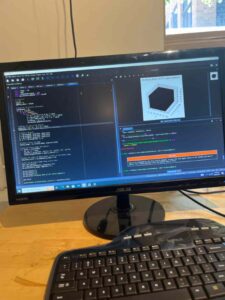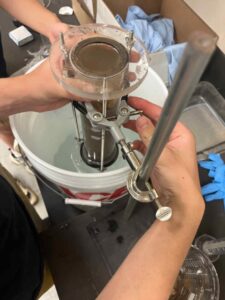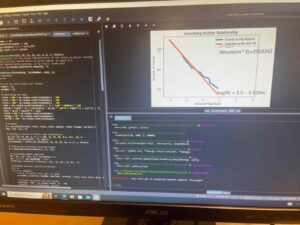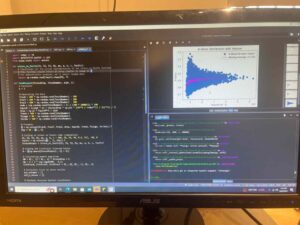Super interesting week for me here at the University of Utah (Salt Lake City). I got to start working on a proposal in order to get funding for some research, started working on a bit of application with REV’s (Representative Elemetary Volumes), and finished up some coding for 3D lattices.
My week started with a pretty long day of coding, but it was totally worth it since I learned how to create a 3-Dimensional binary mesh of whatever lattice I was trying to sample. By making a mesh representing the lattice, I could just take a sample of a given volume at a random point and just count up the number of zeroes (since the zeroes represented void space and I was focusing on calculating porosity).

On Tuesday, Dr. McCormack showed me a term paper he had written in 2015 about the effects of sample volume on the Gutenberg – Richter relationship. He suggested that I could replicate the modeling and develop my own code to potentially explain some of the phenomena he had observed, which had proven difficult to explain. i didn’t actually get around to working on this until Wednesday, but this was mostly because I wanted to really understand the project as a whole before I started doing any coding for it. I also worked on modifying the falling head permeameter. Sophia, another high school intern, and I decided to attach an independent standpipe to our soil sample, allowing us to use a plastic filter. This innovation was significant as it allowed us to use a larger volume of water in the standpipe, enabling measurements over longer periods of time.

The following day, I only worked on the Gutenberg – Richter relationship paper. I spent most of the day figuring out how to create the discrete fracture network (DFN) in order to get synthetic data. This was hard for me since I was having a hard time understanding all the terminology for how a fracture is generated (terms such as plunge, strike, stress drop and trend), but after a little bit of research I understood fracture generation enough to make a 200 x 200 x 200 cube where I generated fractures. I made it so that each event (fracture) was localized at a single point and then used some open forum code to create a linear regression for the log of the number of events of magnitude M or larger vs the magnitude (M). It is in the form log(N) = a – b(M) where a and b are both constants thus making a log – linear relationship between N and M (where N is the number of earthquakes with a magnitude greater than or equal to M).

On Thursday, I only did work with the falling head permeameter. Most of the work was working on a hypothesis for our research and writing up a proposal for the project. We are testing how water saturation and particle size affect permeability and which one has a more siginificant impact on permeability when a sample has competing characteristics. This is our hypothesis (although it may still be revised), ” Both particle size and water saturation influence the permeability of a soil sample. Particle size affects permeability because it affects the sizes of the pore volumes and resultant pore throats. When large particles are present, there is more void space than when the particles are small. Water saturation has an effect on permeability because it changes the amount of void space occupied by air. For example, if a sample is not saturated with water, there are air pockets that the water has to flow through, which block the path and take up void space which could otherwise be filled with water. When a sample has competing characteristics, such as high water saturation and small particle size, we hypothesize that the particle size will have a more significant impact on determining the permeability because the spatial domain of flow is more important than the identity of the displaced fluid. ” After Sophia and I wrote up a little bit of a ‘proposal’ we did some research on where to collect our four samples.
Friday came around and in the morning (while it was still pretty cool out), I walked around the campus looking for different soil samples (small particle size, unsaturated; small particle size, saturated; large particle size, unsaturated; large particle size, saturated). I was planning on using irrigation as a form of water saturation but I was having a hard time finding coarse soil that was also irrigated so I decided to just add water to the sample in order to artificially saturate it (Since the research is a bit more abstract/general, this is probably better than using native state irrigated soil, since we can now control how saturated the soil is). I collected 2 samples for the large particle size soil, but the particles in the soil were a bit too big so I will go and collect more samples on Monday (next week). After I finished some sample collection, I got back to coding for the analysis of Gutenberg-Richter Relationships in randomly sampled volumes. I did not get very far, but I was able to get a scatter plot of the b – values (slope) in the relationship against the volume of the sample. After I did this, I decided to start working on the critical stress calculation (which fractures are actually going to create seismicity). Since the FracMan module for critical stress was faulty, I was going to calculate the stress analytically using Coulomb’s Law but it was a bit too complicated for me. I then went to Dr. McCormack to ask for help and he said he could explain it to me on Monday, but that I could skip it for my code since it really just takes a percentage of the original sample. (I am very happy about this because the critical stress calculations weren’t really making much sense to me).

Then over the weekend I went to the gym and hit chest, shoulders, and triceps on Saturday, then legs on Sunday. I also went climbing up in little cottonwood as well as a bit North of Mount Olympus on some moderately overhanging pocketed limestone. I am having so much fun here in Salt Lake as well as learning tons under Dr. McCormack!

There are no comments published yet.